

Damion Smy
Ford Ranger-sized EV ute must prove itself in US before global rollout
1 Hour Ago
It's big and impractical, but the Jeep Gladiator has something most of its rivals just can't match – it's seriously cool.
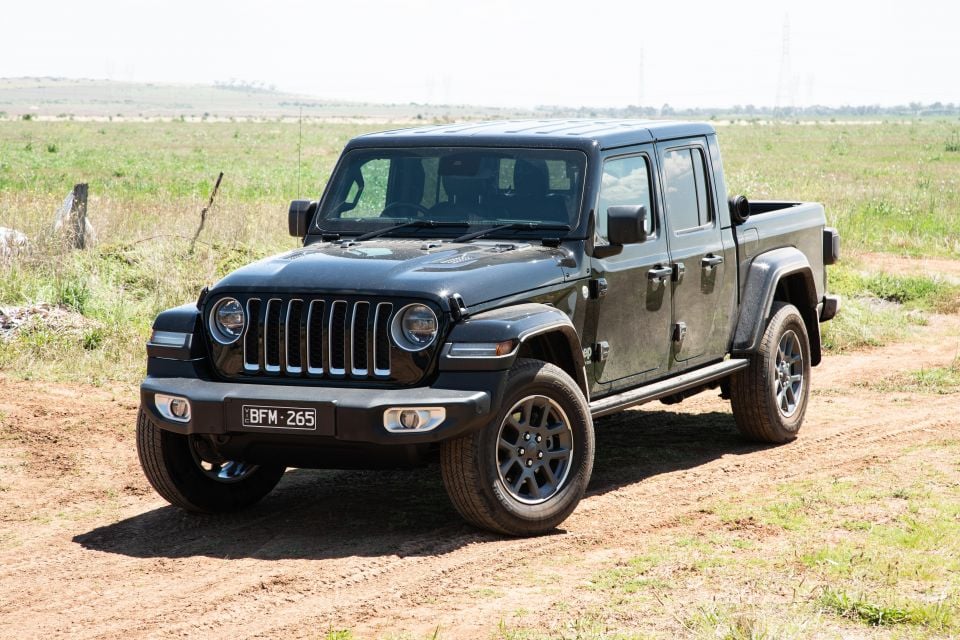
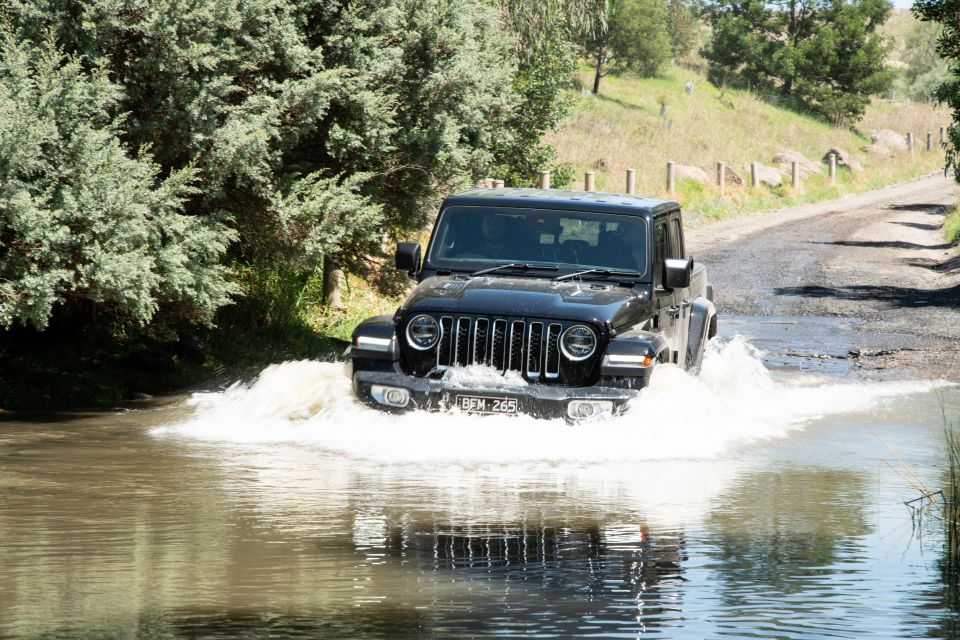

Contributor
New from
$65,450
excl. on-roads

Contributor
New from
$65,450
excl. on-roads


Contributor
New from
$65,450
excl. on-roads

Contributor
New from
$65,450
excl. on-roads
Quickly see how this car stacks up against its competition. Select any benchmark to see more details.
Where expert car reviews meet expert car buying – CarExpert gives you trusted advice, personalised service and real savings on your next new car.
There are plenty of dual-cab utes on sale in Australia, but there’s only one Jeep Gladiator.
Unveiled in 2018, the Gladiator is a unique take on the path trodden by the Ford Ranger and Toyota HiLux.
Long and narrow, it sacrifices load-lugging ability at the altar of style and off-road performance. With a three-star safety rating, it sacrifices outright crash ability to let you remove the roof, windscreen, and doors.
It’s expensive and flawed, but it’s also damn cool.
Pricing for the Gladiator range kicks off at $65,450 before on-roads for the new Sport S model, but the Gladiator Overland on test here is priced from $75,450 before on-road costs.
The range-topping Gladiator Rubicon is priced at $76,450 before on-roads.
You couldn’t call even the entry-level Gladiator cheap, then. But the Overland goes head-to-head with some pretty serious metal, including the Ford Ranger Raptor ($77,690).
Beyond its sticker price, our tester was fitted with the Lifestyle and Adventure Package ($2950).

Buy your new car without the stress. It's fast, simple and completely free.

Great service from Travis and team, second time I have used this business would not hesitate to recommend them to anyone
Craig C.
Purchased a Ford Ranger in Sunshine Coast, QLD
CarExpert helped Craig save thousands on his Ford Ranger, now let us save you on your next new car.
Find a dealStandard kit across the Gladiator range includes LED headlights and tail lights, keyless entry and start, automatic headlights, a 7.0-inch trip computer, a nine-speaker Alpine sound system, and dual-zone climate control.
Moving up to the Overland brings an 8.4-inch touchscreen infotainment system with Android Auto, Apple CarPlay and satellite navigation, remote start, leather trim, and heating for the front seats and steering wheel.
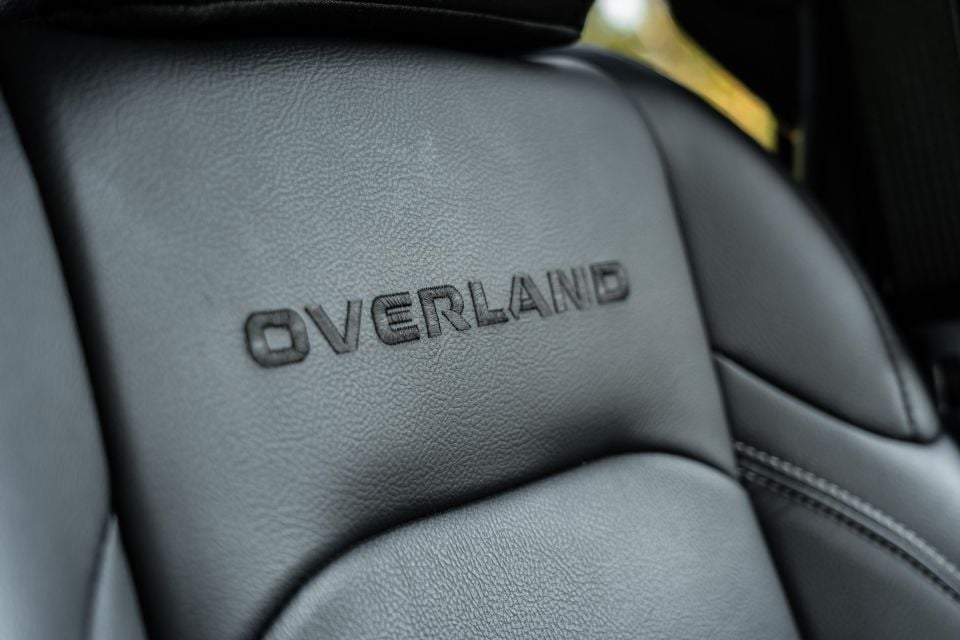
It rides on 18-inch alloy wheels and packs a removable, body-coloured hardtop and fender flares.
The Lifestyle and Adventure Package fitted to our tester added a roll-up tonneau cover, trail rail tie-down hooks for the tray, a lockable storage bin down back, a spray-in bed liner, a wireless speaker, four auxiliary switches, a 240A alternator, and a 700A battery.
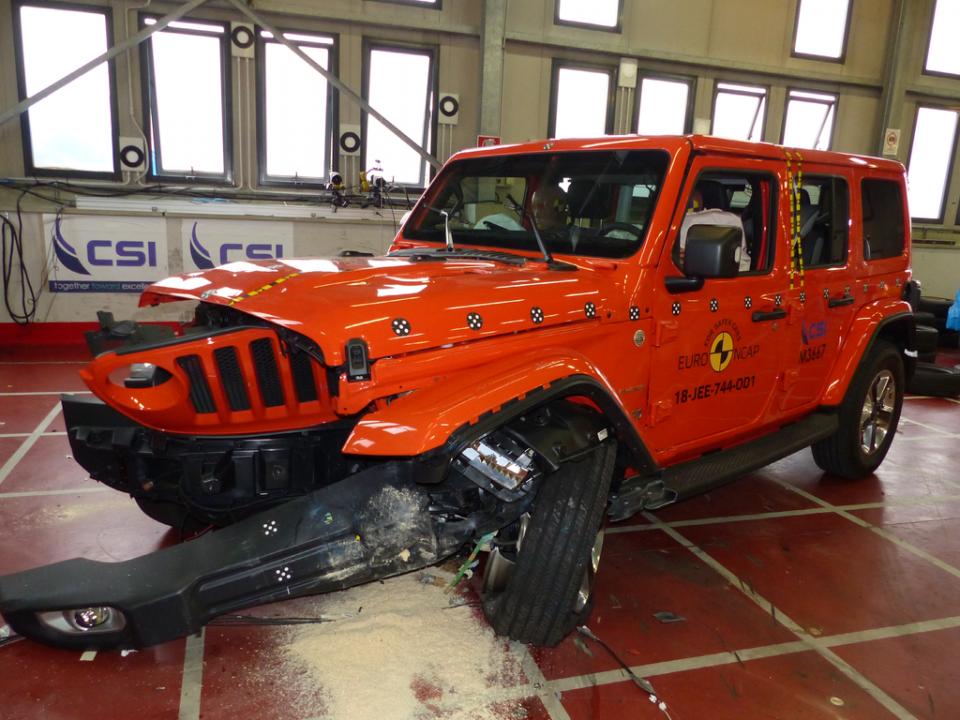
The Jeep Gladiator wears a three-star rating from ANCAP with a 2019 date stamp.
ANCAP gave the Gladiator the same rating and category scores as the Wrangler due to the two models’ close relation.
The Gladiator received an adult occupant protection score of 60 per cent, child occupant protection score of 80 per cent, vulnerable road user protection score of 49 per cent, and a safety assist score of 51 per cent.
All 2021 Jeep Gladiator models come standard with the following safety and driver assist features:
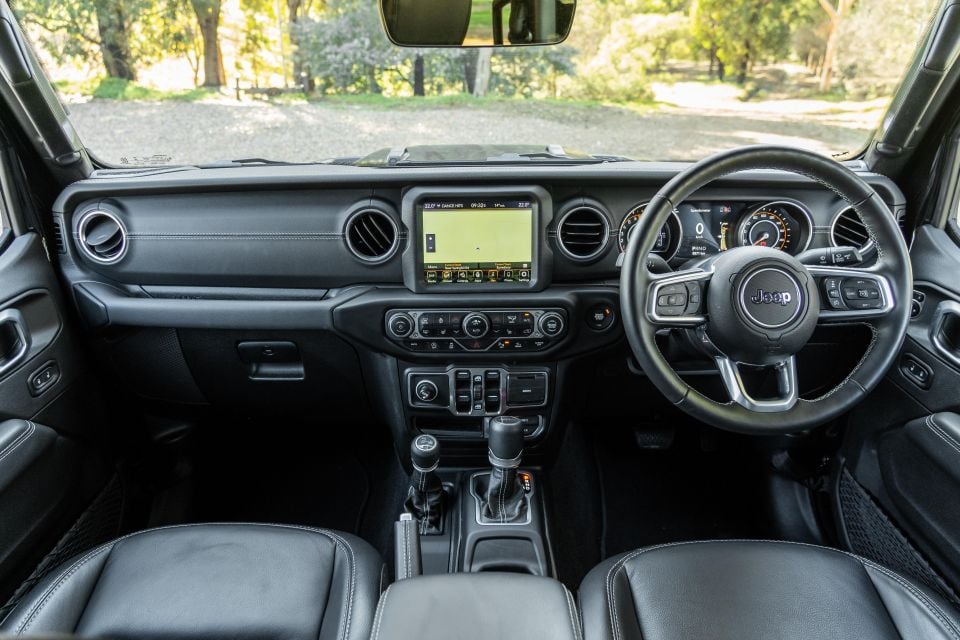
If you’ve sat in a Wrangler, you’ve sat in a Gladiator.
It’s a rugged-looking space dominated by the vertical dashboard, with some excellent technology and slightly questionable ergonomics.
First up, the good. The driver and passenger sit in comfortable, squishy seats that offer an excellent view of the road ahead, and the driving position is surprisingly good.
Being able to see the corners of the bonnet helps place what is a huge car in the city, too.
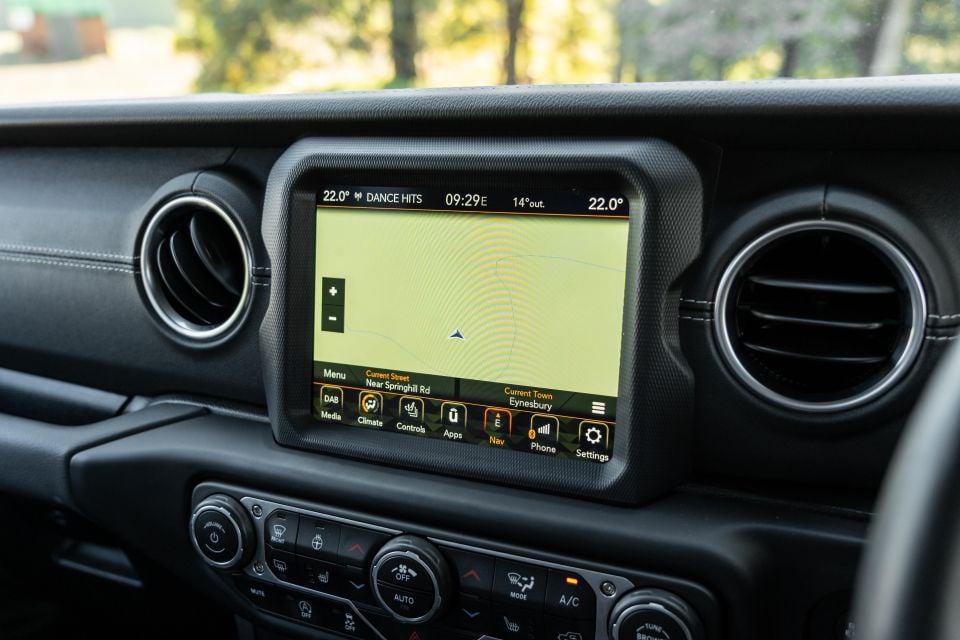
Jeep’s infotainment technology is top notch, with snappy responses and a full feature set.
It starts up fast and there’s minimal menu diving required to move around its various functions, both of which are big ticks.
Although factory navigation is standard, we leaned on Apple CarPlay for mapping. It isn’t wireless, but it worked flawlessly when plugged in.
Below the screen is a bank of rubberised switches for climate control, things like the parking sensors, and the windows. When your doors can be removed, the switches for the windows need to stay in the car.
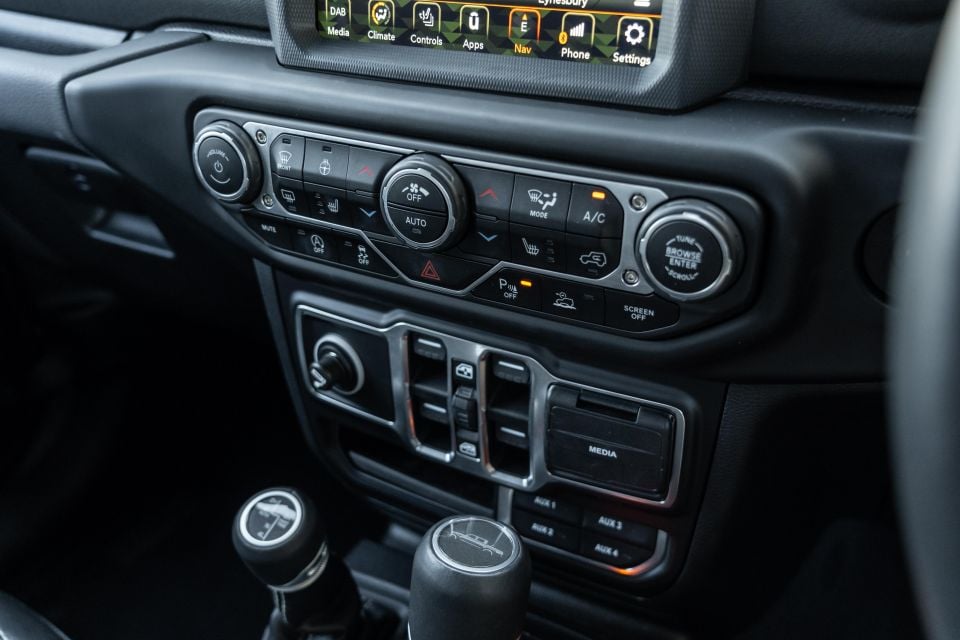
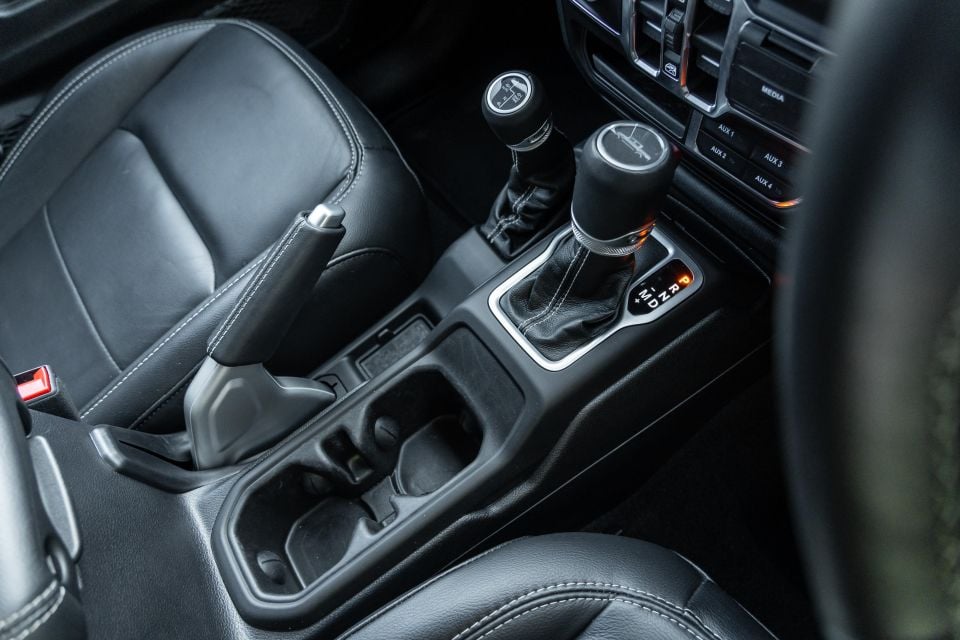
All the things you touch, from the chunky leather wheel to the chubby gear selector, feel both expensive and rugged, which is a tough tightrope to walk.
Storage is fine, from the large cupholders to the deep central bin, but there’s no space under the dashboard and the doors only have flimsy wire pockets.
As for the bad? There’s no proper footrest because there’s a pronounced hump where the driver’s left foot should sit, a lot of the materials feel hard wearing but cheap.
Fiat Chrysler’s determination to use the space behind the steering wheel for media controls rather than paddle shifters remains frustrating.
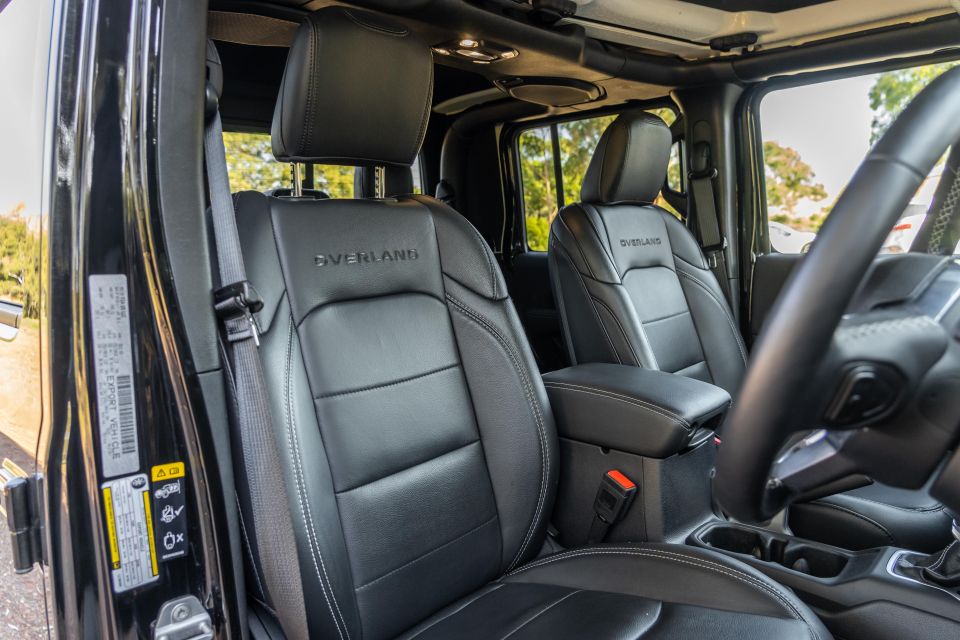
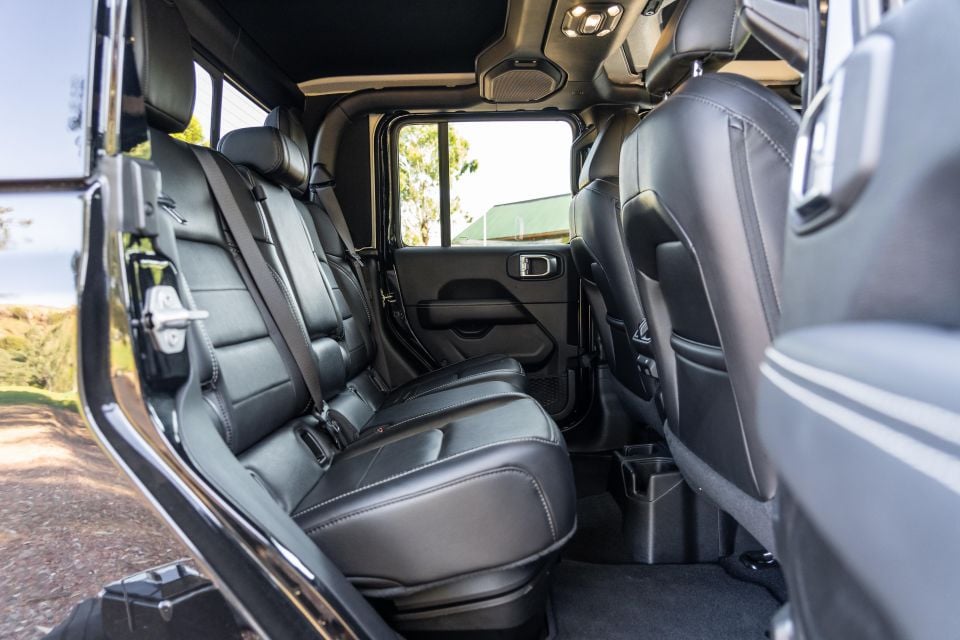
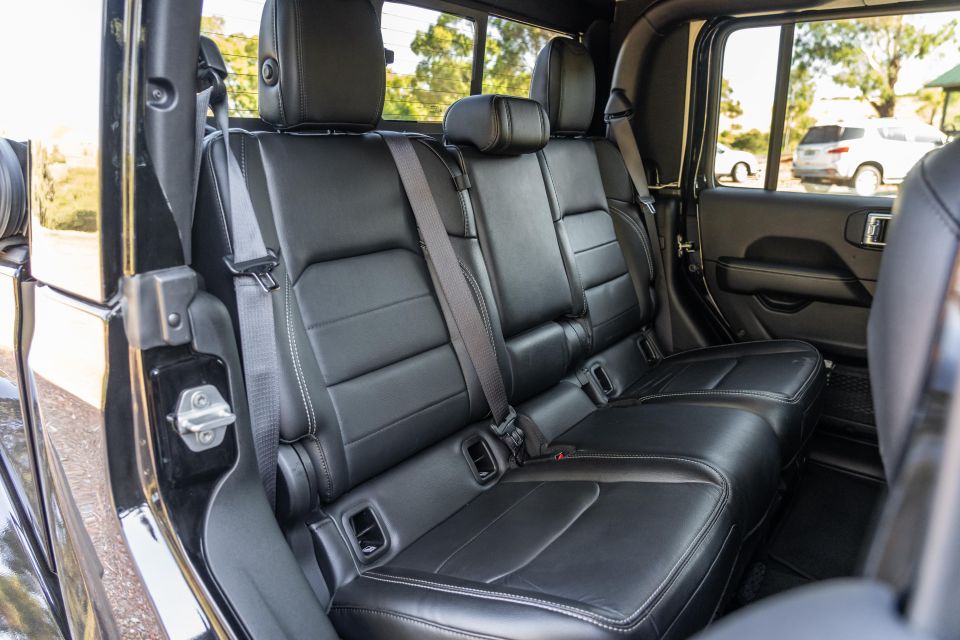
Rear seat space is actually quite good, although the tiny rear door and protruding metal latch make getting in far harder than it should be – I have the bruise on my hip to prove it.
Legroom is good for adults sitting behind adults, and headroom is similarly generous thanks to the boxy profile. There are air vents and USB chargers back there, along with ISOFIX points on the outboard seats.
Flipping up the rear bench reveals a space to store the tools and screws required to take the car apart, along with a locking storage space.
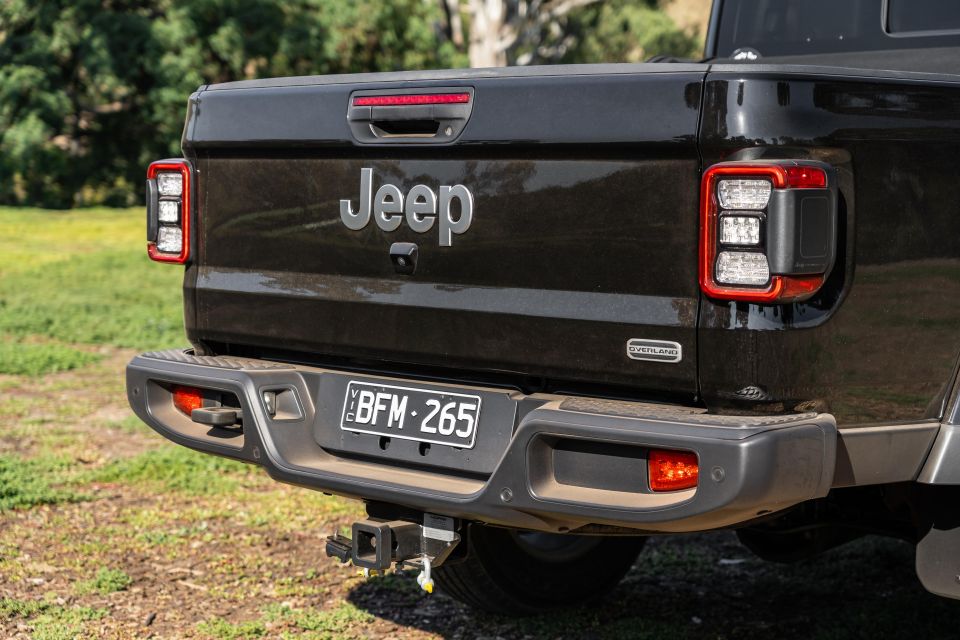
The tray is dependent on the options boxes you’ve ticked.
Outfitted with a bed liner and sliding tie-down hooks like our tester it’s a practical space, but at $75,000 before options you really shouldn’t be ticking boxes for a fully-functional tray.
The soft tonneau cover option is easy to use but doesn’t feel particularly secure compared with the roll-top cover on offer in the Ford Ranger Wildtrak, either.
Measuring up at 1531mm long and 1137mm wide between the wheel arches, the tray is actually shorter than that of a Ford Ranger.
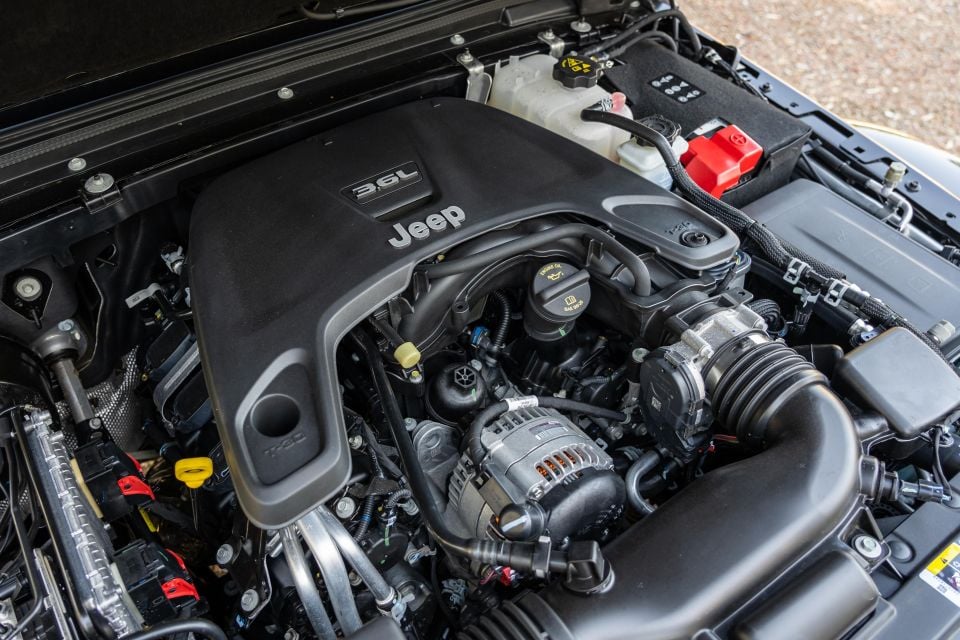
The Gladiator houses a naturally-aspirated 3.6-litre petrol V6 engine. It produces 209kW of power and 347Nm of torque, and is mated to an eight-speed automatic transmission.
Unlike the range-topping Rubicon, the Overland uses an on-demand four-wheel drive system with low-range but no locking differentials.
It drinks 11.2L/100km on the ADR combined cycle, but we saw more than 13.5L/100km in the real world.
Braked towing capacity is 2721kg, with a tow ball download of 272kg, and the car’s payload is 527kg.
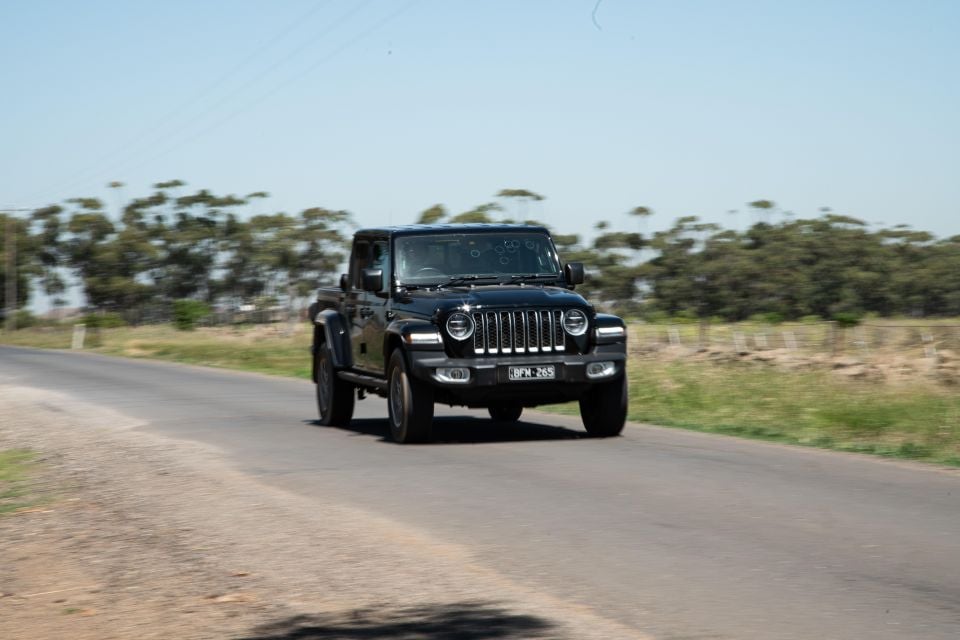
The Gladiator really benefits from its size on the road.
It’s seriously comfortable, with a lovely soft ride and relaxed demeanour on the open road. Then again it’d want to be, given its limo-like 3488mm wheelbase.
Speed bumps and potholes just float beneath you, and there’s something relaxing about how it lopes along the highway. With coil springs attached to solid axles at both ends it isn’t the last word in sophistication, but it is effective.
Where it feels slightly less planted is unladen on gravel roads. The rear end feels a bit skittish over corrugations, and the Gladiator doesn’t quite have the planted feeling at the front of some of its locally-tuned rivals.
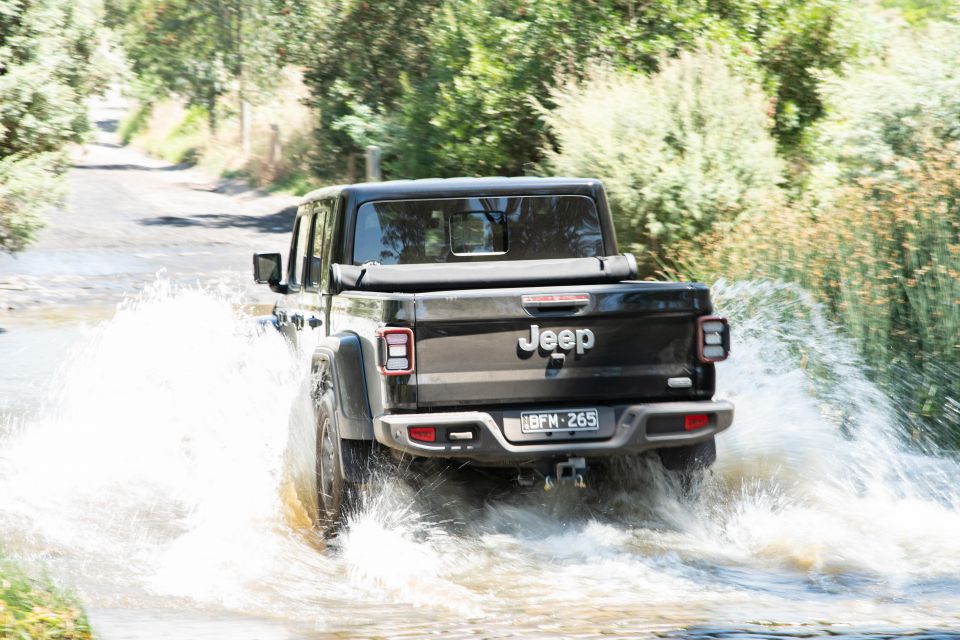
The cushy ride is paired with vague, slow steering that requires constant inputs if you’re planning to stay on the straight and narrow.
It’ll make classic Jeep people feel right at home, although similarly-priced ute rivals feel more planted on the move.
Piloting the Gladiator in the city is hard work given its length, and you’ll need to get cracking on those bicep curls if you’re frequently making three-point turns.
Thankfully the rear-view camera is clear and visibility from the boxy body is good, so coming to grips with the Gladiator’s size doesn’t take too long.
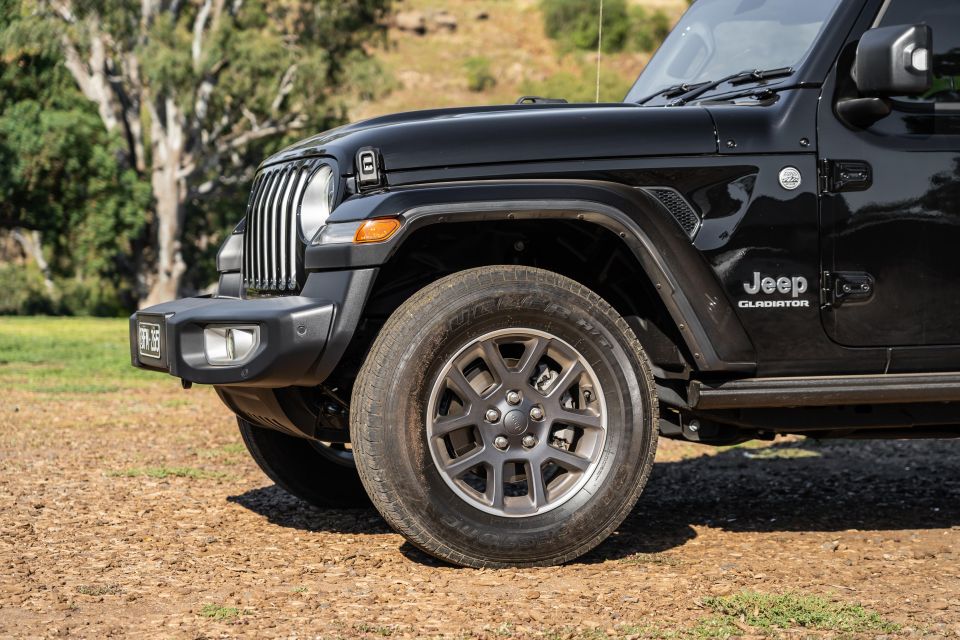
The long-serving Pentastar V6 engine does a good job getting the Gladiator up to speed and keeping it there.
It lacks the low-down punch of a turbo-diesel, but counters with smooth response and a relatively muted sound in the cabin. The eight-speed auto is a smart partner, keeping the engine between 3500 and 4100rpm where torque is plentiful when the driver leans on the throttle.
Really plant your right foot and the transmission will hang onto gears all the way to redline.
Despite its removable roof and blocky profile, the Gladiator is surprisingly refined on the open road. Wind noise isn’t bad, the tyres on the Overland don’t rumble or roar, and the engine settles down nicely at highway speeds.
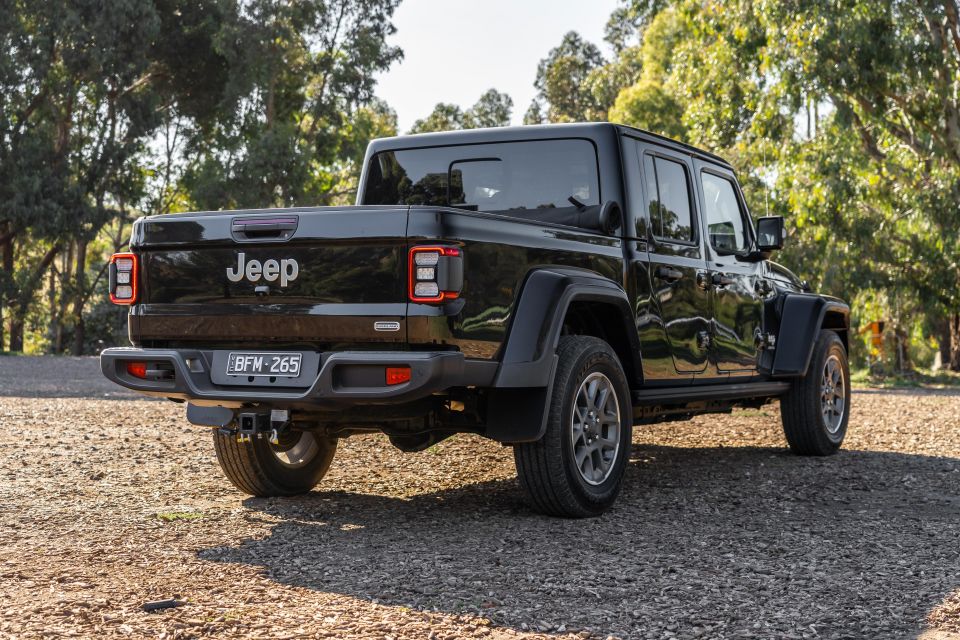
Where expert car reviews meet expert car buying – CarExpert gives you trusted advice, personalised service and real savings on your next new car.
It’s a bit wallowy in the corners, but this isn’t meant to be a sports car. Trying to push the Gladiator hard is like making an NFL lineman run; funny but futile.
Flicking to four-wheel drive and low-range is handled by a classic-looking (but electrically-operated) lever next to the gear selector.
The car slots smoothly from two- into four-wheel drive, and from high-range into low-range, and the lever is more tactile than a little knob or button.
Off the beaten path? I’ll reserve full judgement because our off-road editor, Simon Christie, has words about how the Gladiator performs incoming.
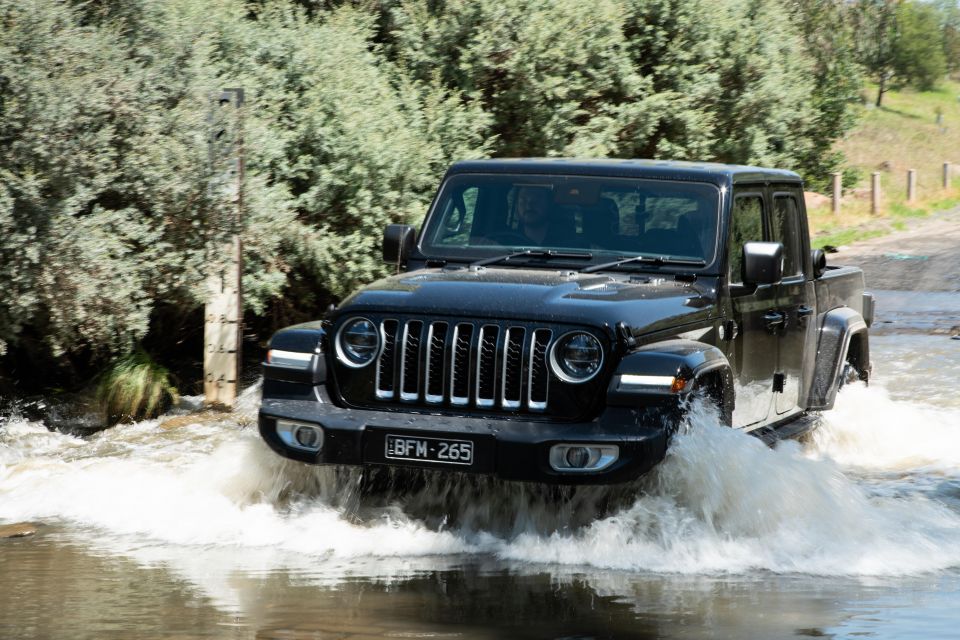
But it’s safe to say the Gladiator is capable, if slightly hampered by its dimensions.
Where the Gladiator really plays its trump card is when you take it apart. For two mechanically-challenged men taking off the doors, roof, and windscreen took around 40 minutes, but with a second tool (the Jeep kit includes one) and a bit more practice you could cut that time down.
Stripped of its armour, the Gladiator is like nothing else on the road. It’s not like driving a convertible, it’s much more immersive than that – you’d get dusty on a day in the dunes, but you’d also feel a bigger part of the off-roading process.
It’s just damn cool, and if you’re really into the outdoor experience there’s no ute that can match it.

The 2021 Jeep Gladiator Overland requires servicing every 12 months or 12,000km.
In addition to a five-year, 100,000km warranty, Jeep offers five years of capped-price servicing. Each service costs $399.
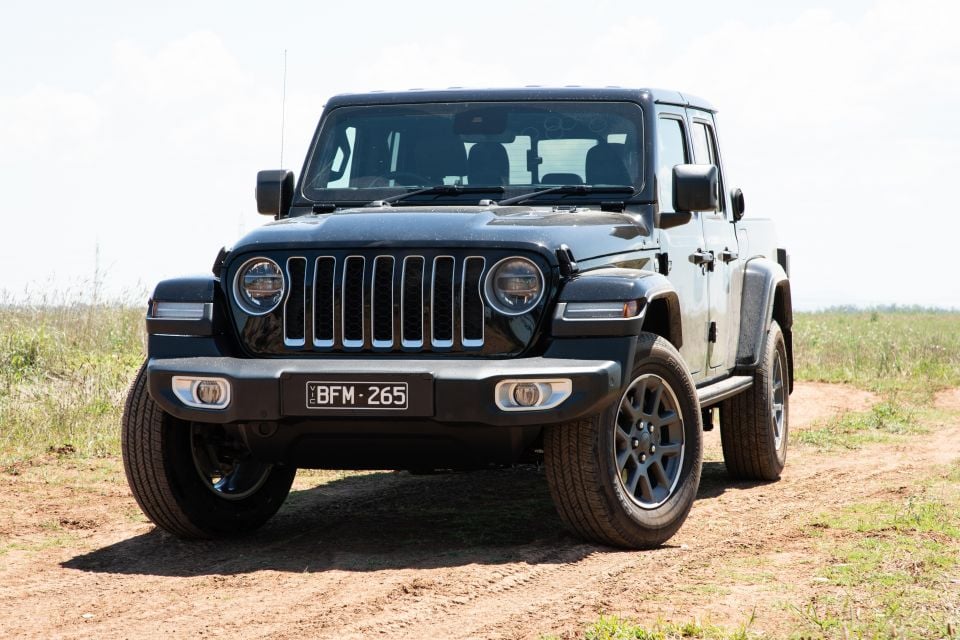
The Gladiator isn’t the best ute you can buy on the road or off it.
It’s old-fashioned to drive, questionably packaged in places, and lacks a diesel option.
In other words, there are better utes out there. But there aren’t cooler ones.

It’s a bit silly to look at this oversized Tonka Truck through a conventional lens, because if you want one and can afford one, well, you’ll probably buy one.
If you are going to do that, the Overland feels slightly lost in the Gladiator range.
The arrival of the Sport S makes the Overland slightly redundant as a base for keen modifiers, especially with the $2500 luxury pack fitted, and the jump to the range-topping Rubicon is minimal if you’re going to leave it stock and hit the trails.
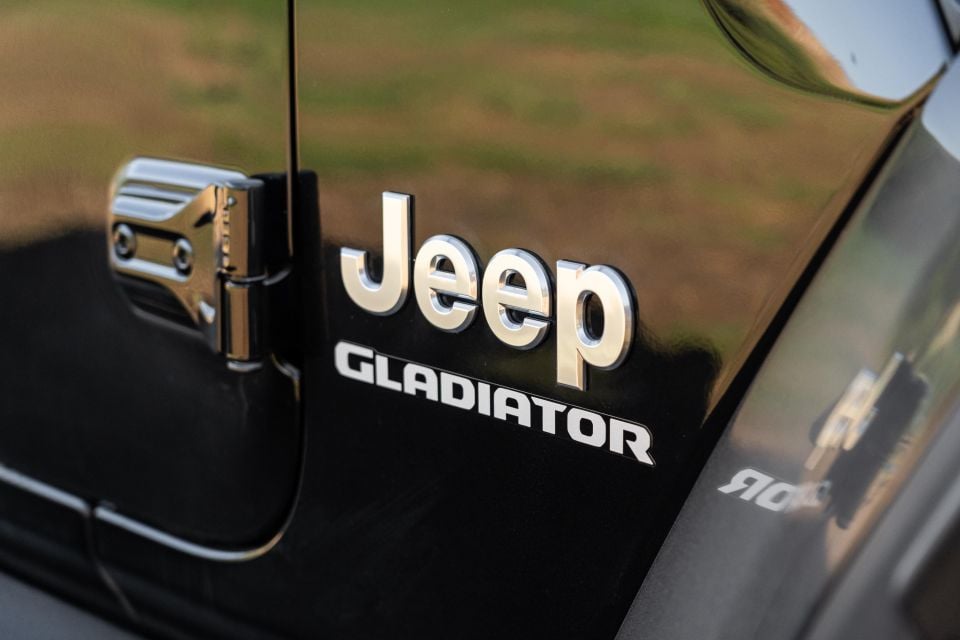
Click the images for the full gallery
Where expert car reviews meet expert car buying – CarExpert gives you trusted advice, personalised service and real savings on your next new car.
Scott Collie is an automotive journalist based in Melbourne, Australia. Scott studied journalism at RMIT University and, after a lifelong obsession with everything automotive, started covering the car industry shortly afterwards. He has a passion for travel, and is an avid Melbourne Demons supporter.


Damion Smy
1 Hour Ago


Damion Smy
3 Hours Ago


Damion Smy
4 Hours Ago


William Stopford
6 Hours Ago


Matt Campbell
14 Hours Ago


Max Davies
1 Day Ago